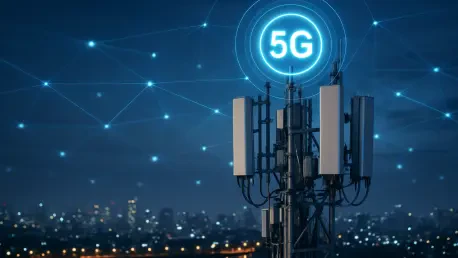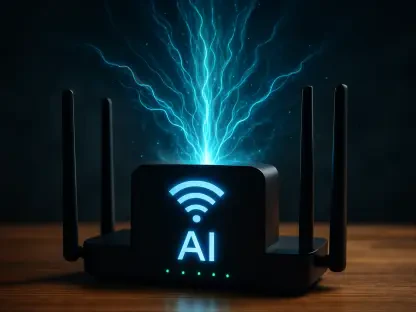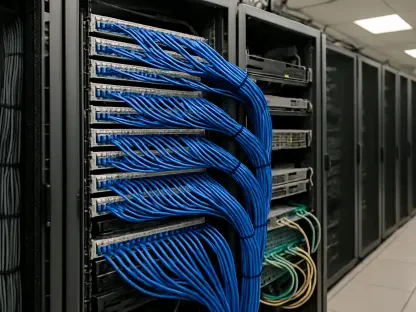Imagine a world where businesses run without interruption, sustainability targets are achieved effortlessly, and groundbreaking technologies like Artificial Intelligence (AI) and the Internet of Things (IoT) operate flawlessly across industries. This vision is no longer a distant hope but a tangible reality that 5G networks are ready to support. As digital connectivity emerges as the cornerstone of modern enterprise, 5G technology stands tall as the linchpin for unlocking unparalleled potential. It’s not merely an upgrade to existing systems; it represents a fundamental shift in how industries function, how workforces collaborate, and how societies address pressing challenges like environmental impact. From revolutionizing operational efficiency in sectors like manufacturing to enabling seamless communication for a dispersed workforce, 5G is reshaping the landscape of a digital-first era. This transformative power makes it a critical topic for businesses aiming to stay ahead in an increasingly connected and competitive global market.
Debunking the Cost Barrier of 5G Adoption
The perception that 5G deployment carries an exorbitant price tag remains a significant obstacle for many organizations considering this technology. Businesses often focus on the initial investment, overlooking the broader financial picture that includes long-term benefits. Industry insights, such as those from leading telecommunications experts, suggest that evaluating the total cost of ownership reveals a different perspective. When factoring in the potential return on investment, the narrative shifts from cost to value. Companies that hesitate to adopt 5G risk falling behind competitors who recognize the strategic advantage of enhanced connectivity. The expense of not investing could manifest as missed opportunities in innovation, efficiency, and market positioning. Addressing this misconception is crucial, as it encourages decision-makers to prioritize strategic growth over short-term budget constraints, paving the way for widespread 5G integration across various sectors.
Another angle to consider is the hidden cost of inaction in the face of evolving digital demands. Sticking with outdated connectivity solutions can lead to inefficiencies, such as slower data processing or unreliable networks, which directly impact productivity. For industries reliant on real-time data—think logistics or healthcare—these delays can translate into significant financial losses or compromised service quality. In contrast, 5G offers a robust framework that mitigates such risks by providing faster, more reliable connections. This reliability isn’t just a technical upgrade; it’s a safeguard against the escalating costs of downtime and operational bottlenecks. By reframing the conversation around 5G as an investment rather than a burden, businesses can better align their strategies with the demands of a hyper-connected future, ensuring they remain agile and responsive to market shifts.
Revolutionizing Technology Integration with 5G
At its core, 5G transcends the notion of merely faster internet speeds; it serves as a catalyst for seamlessly integrating cutting-edge technologies like AI, IoT, and operational systems into cohesive frameworks. Envision manufacturing plants where machinery communicates in real time to prevent breakdowns, or logistics firms optimizing delivery routes dynamically to save time and resources. These scenarios are no longer speculative—they are practical outcomes driven by 5G’s unparalleled bandwidth and low latency. Such capabilities allow businesses to create interconnected ecosystems where data flows effortlessly between devices and systems, enhancing decision-making and operational precision. For managed service providers and partners, this integration opens doors to offer innovative solutions that differentiate them in a crowded marketplace, positioning 5G as a cornerstone of technological advancement.
Beyond individual applications, 5G fosters a holistic approach to digital transformation by bridging gaps between information technology and operational technology. This convergence enables a unified management system that can monitor and optimize processes across diverse sectors, from retail to agriculture. For instance, farmers can leverage IoT sensors powered by 5G to track soil conditions and automate irrigation, maximizing yield while conserving resources. Similarly, retailers can use real-time data to manage inventory with pinpoint accuracy, reducing waste and improving customer satisfaction. These examples highlight how 5G acts as an enabler of efficiency, allowing industries to harness data in ways previously unimaginable. As businesses increasingly adopt these integrated systems, the role of 5G in driving innovation becomes undeniable, solidifying its status as a foundational technology for future growth.
Advancing Sustainability Goals Through Connectivity
One of the less discussed but equally impactful benefits of 5G lies in its potential to support sustainability initiatives across industries. Research from leading telecommunications studies indicates that a remarkable 83% of business leaders believe enhanced connectivity can play a pivotal role in achieving environmental objectives. By enabling smarter resource management—such as reducing fuel consumption through optimized logistics or minimizing water usage in agriculture—5G empowers companies to lower their ecological footprint. This alignment of digital solutions with green practices demonstrates that technological advancement and environmental responsibility are not mutually exclusive but rather complementary. As organizations face mounting pressure to adopt sustainable practices, 5G emerges as a vital tool in balancing profitability with planetary well-being.
Moreover, the ability of 5G to facilitate real-time monitoring and data analysis contributes directly to waste reduction and energy efficiency. Consider smart grids in the energy sector, where 5G connectivity allows for precise tracking of power usage, preventing overloads and optimizing distribution. Such applications not only cut operational costs but also curb unnecessary energy waste, supporting broader climate goals. Additionally, industries like transportation benefit from 5G-driven innovations that streamline fleet operations, reducing emissions through better route planning and vehicle maintenance. These advancements underscore a growing recognition that robust connectivity, underpinned by 5G, is essential for creating environmentally conscious business models. As sustainability becomes a core metric of corporate success, the adoption of 5G offers a clear path to meeting both regulatory and societal expectations.
Supporting the Evolving Hybrid Workforce
The modern workforce, characterized by a blend of remote and on-site employees, presents unique connectivity challenges that 5G is uniquely positioned to address. With workers splitting time between home offices and corporate environments, ensuring secure and reliable access to data is paramount. Remote employees often face heightened security risks due to unsecured networks, while office settings grapple with the potential for widespread disruption from downtime. 5G technology offers a flexible solution, delivering high-speed, stable connections that adapt to varying environments. This adaptability ensures that teams remain productive regardless of location, addressing a critical need in today’s dynamic work landscape where seamless communication is non-negotiable for operational success.
Furthermore, the reach of 5G extends beyond urban centers, providing a lifeline for employees in rural or underserved areas where traditional connectivity options may fall short. This inclusivity is vital for businesses with dispersed teams, ensuring that all employees have equal access to tools and resources necessary for their roles. For instance, field workers in industries like construction or utilities can rely on 5G to access real-time data, enhancing on-site decision-making without the delays associated with weaker networks. This capability not only boosts individual productivity but also strengthens overall organizational resilience against connectivity disruptions. As hybrid work models continue to evolve, 5G stands as a critical enabler, bridging geographical and technological divides to maintain a cohesive, efficient workforce.
Pioneering Hybrid Connectivity for Diverse Needs
Industries operating in remote or challenging environments, such as utilities or energy, often struggle with maintaining consistent connectivity—a challenge that hybrid solutions incorporating 5G are beginning to solve. By combining cellular 5G networks with fixed-line and satellite technologies, businesses can ensure uninterrupted access to critical data, even in the most isolated locations. Data reveals that 30% of Australian organizations already utilize satellite connectivity in rural areas, highlighting a shift toward diverse, resilient systems. This hybrid approach moves away from a one-size-fits-all mentality, tailoring solutions to specific operational needs and geographic constraints. 5G’s integration into this mix enhances the reliability and speed of these connections, making it a cornerstone of inclusive digital infrastructure.
Additionally, hybrid connectivity supported by 5G addresses the growing demand for security and uptime in critical operations. For sectors where a single point of failure can have catastrophic consequences—like power grid management—having multiple connectivity options ensures redundancy and continuity. Workers in remote field locations can transmit real-time updates on infrastructure status, enabling swift responses to potential issues. This layered approach not only mitigates risks but also fosters trust in digital systems among stakeholders. As industries increasingly recognize the limitations of traditional connectivity, the adoption of hybrid models with 5G at the helm signals a progressive step toward operational resilience. This trend underscores the technology’s role in ensuring that no region or sector is left behind in the digital era.
Building a Future-Ready Business with 5G
Statistical insights paint a compelling picture of 5G’s inevitability in the business landscape, with 80% of companies planning to integrate AI and 63% already leveraging cellular networks for IoT applications. These figures emphasize a fundamental truth: 5G is not a luxury but a necessity for organizations aiming to remain competitive in a rapidly digitizing world. Its capacity to support data-intensive technologies ensures that businesses can innovate without the constraints of outdated infrastructure. From enabling smart cities to powering autonomous systems, 5G lays the groundwork for operational efficiency and market differentiation, positioning it as an indispensable element of digital transformation strategies across the globe.
Looking ahead, the trajectory of 5G adoption suggests an even deeper integration into core business functions over the coming years, from now through 2027 and beyond. Its role in facilitating real-time analytics and scalable solutions will be crucial for industries navigating complex challenges, such as supply chain disruptions or evolving customer expectations. Managed service providers and partners also stand to play a pivotal role, guiding companies through the intricacies of 5G implementation and hybrid connectivity models. This collaborative approach will be essential for addressing skill gaps and ensuring that the technology’s full potential is realized. As digital demands continue to escalate, 5G remains the bedrock upon which future-ready enterprises will build their success, ensuring they are equipped to thrive in an interconnected, innovation-driven economy.
Reflecting on 5G’s Transformative Impact
Looking back, the journey of 5G unfolded as a pivotal chapter in the story of digital connectivity, reshaping how businesses tackled operational and environmental challenges. Its ability to debunk cost myths provided a fresh lens through which companies viewed investment in technology, prioritizing long-term value over initial hurdles. The seamless integration with AI and IoT marked a turning point, as industries harnessed real-time data to drive efficiency and innovation. Meanwhile, the support for sustainability and hybrid workforces addressed pressing societal shifts, ensuring that connectivity served both profit and purpose. As hybrid models gained traction, they bridged gaps in remote regions, proving that inclusivity was achievable through strategic tech adoption. Moving forward, the focus should shift to scaling expertise and partnerships, equipping businesses with the tools to navigate this complex landscape. Exploring further advancements in 5G applications could unlock even greater potential, ensuring that digital transformation remains a dynamic, inclusive process for all.









